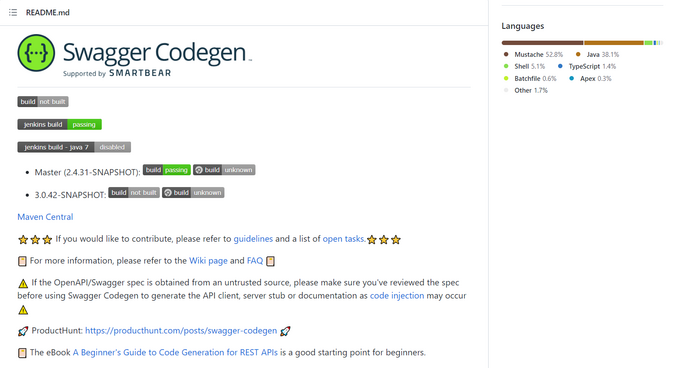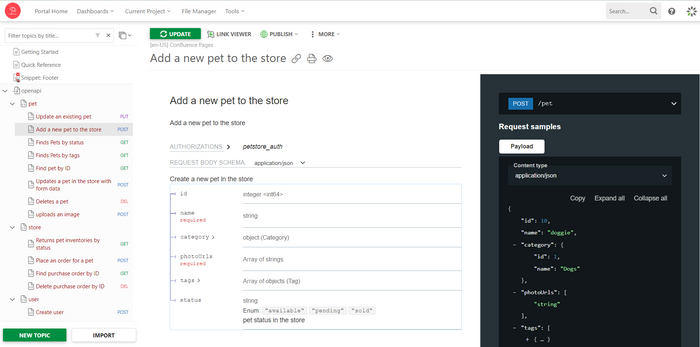
If you are an API technical writer, chances are you have heard of Swagger. In this blog, we will explain the main tools that Swagger offers, the advantages of this powerful platform, and ways to connect your API documentation created in Swagger with your user manuals.
What Is Swagger?
Swagger is a set of open-source tools for building and documenting APIs. This toolset is built around the Swagger/OpenAPI specification that is based on JSON (JavaScript Object Notation) or YAML (YAML Ain’t Markup Language). The spec provides a standardized way of describing the various components of an API, such as its endpoints, parameters, responses, and security requirements.
The main tools of Swagger are Swagger Editor, Swagger UI, and Swagger Codegen. Swagger Editor enables users to write and edit API documentation and OpenAPI definitions. You can access this editor through a browser, download it for local use, or use it through a hosted version.

To share the documentation created using the editor with the target audience, you can use Swagger UI. This tool transforms an OpenAPI definition into interactive API documentation. Swagger UI converts the YAML or JSON file into a user-friendly format that presents API calls in an interactive manner.

Finally, to bring the API to life, you need to implement server logic. This is where Swagger Codegen comes in. This tool generates server stubs, client SDKs, and client libraries from an OpenAPI definition. With Swagger Codegen, the process of implementing server logic becomes much easier and more efficient.

8 Advantages of Swagger and a Significant Limitation
So this powerful platform:
- Reduces errors. The Swagger/OpenAPI specification can help to reduce errors and inconsistencies in the API development. By providing a clear and consistent definition of an API, it is easier to understand and implement the API correctly.
- Simplifies testing. Swagger provides a user-friendly interface for exploring and testing APIs. This can help developers to quickly test and validate their APIs, reducing the time and effort required for testing.
- Facilitates collaboration. By providing a common language and format for describing APIs, Swagger can ease collaboration between team members, including developers, testers, and technical writers. This can help to improve communication and reduce misunderstandings.
- Improves maintenance. The API documentation created in Swagger can help to improve APIs’ maintainability. By providing a clear and up-to-date description of the API, it is easier for developers to maintain and update APIs over time.
- Enables API monitoring. Monitor API availability, speed, and functionality starting from your OpenAPI definition. This approach can help to identify and resolve issues before they become major problems.
- Offers a neat UI. Swagger provides the user-friendly interface for exploring and testing APIs, which can help to improve the overall quality of API documentation.
- Allows versioning. Versioning allows developers to maintain multiple versions of an API over time. This feature can help to ensure backward compatibility and reduce the risk of breaking changes.
- Provides integrations. Swagger can be integrated with various other tools and frameworks, such as Postman, Jenkins, and Docker, which can help to streamline the development and deployment of APIs.
As you can see, Swagger has a lot of benefits regarding different use cases. However, technical writers create not only API documentation but also knowledge bases. It means that using Swagger is not enough for full-fledged technical writing, but we have something to offer.
Import a Swagger/OpenAPI Definition to ClickHelp
ClickHelp is a help authoring tool — you can easily maintain technical documentation there. Although you can create API documentation in ClickHelp, some technical writers prefer using specialized tools (such as Swagger) for these purposes. The great decision is to connect two professional platforms, and we’ll explain why.
So the reasons to import Swagger/OpenAPI definitions to ClickHelp are as follows:
- Centralized document access. When you host your API documentation in SwaggerHub, your user guides are on another platform. It means that your end users can’t easily find the required information in a single site — they have to switch between two platforms and lose time.
But if you import your Swagger/OpenAPI definition to ClickHelp, you will instantly improve your end users’ experience. Thanks to the full-text search features, your readers will find information about API methods and user manuals in one portal.
- Consistent branding of all documents. Every company has its own style and branding, and this approach regards the documentation design. So when the portal branding with user guides differs from the appearance of API documentation, your brand awareness will be worse.
Importing your definitions solves the problem of branding differences. Your API documentation topics will be automatically published in accordance with ClickHelp portal branding.
- Managing different topics in one project. In ClickHelp, you can create additional topics inside one project with the API documentation imported. This scenario is especially helpful when you need to explain some difficult API use cases to novice end users. Besides, the additional topic may contain visuals that you normally use in documentation.

Importing definitions to ClickHelp doesn’t mean that you don’t need Swagger anymore. The thing is, the imported API documentation will be just duplicated and divided into topics — you will proceed with managing API documentation in Swagger and then refresh corresponding topics in ClickHelp by clicking Update. The integration of two powerful tools will broaden your possibilities.
Conclusion
Swagger offers great tools for developing and documenting APIs. It has a neat UI, facilitates collaboration, and provides other overwhelming benefits. Nevertheless, you can maintain only API documentation there, so your user guides and other technical documentation will be hosted on another portal. To solve this problem, just import your Swagger/OpenAPI definition to ClickHelp and enjoy the powerful integration.
Good luck with your technical writing!
ClickHelp Team
Author, host and deliver documentation across platforms and devices
